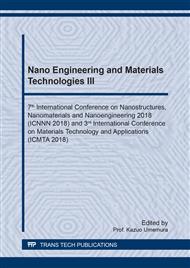p.178
p.185
p.190
p.195
p.200
p.207
p.212
p.217
p.222
Morphology and Mechanical Properties of Poly(Lactic Acid) with Propylene-Ethylene Copolymer and α-Cellulose
Abstract:
This work studied the improvement of poly (lactic acid) (PLA) properties by adding propylene-ethylene copolymer (PEC) and α-cellulose (AC). The PLA blends and composites were melt mixed by an internal mixer and molded by compression method. The morphological analysis observed the phase separation of PLA/PEC blends due to minor PEC phase dispersed as spherical shape in PLA phase, indicating a poor interfacial adhesion between PLA and PEC phases. The incorporation of AC did not improve the compatibility of polymer blends. Young’s modulus and tensile strength of PLA blends reduced with increasing amount of PEC because the elastics of ethylene molecules in PEC structure. Young’s modulus of PLA/PEC/AC composites increased with increasing AC contents. The stress at break of the PLA/PEC blends was improved with the presence of AC. The strain at break of PLA/PEC blends increased with increasing PEC contents, and the presence of AC showed the decrease of strain at break of PLA/PEC blends.
Info:
Periodical:
Pages:
200-204
Citation:
Online since:
March 2019
Price:
Сopyright:
© 2019 Trans Tech Publications Ltd. All Rights Reserved
Share:
Citation:


